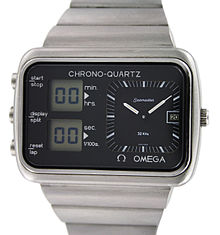User:Omega-collector/sandbox

Introduction
[edit]The Omega Chrono-Quartz was the world’s first digital/ analogue chronograph. It was invented by Omega SA. The watch launched at the 1976 Montreal Olympic Games and was Omega's flagship chronograph at that time. The watch is noteworthy as it was the first chronograph wristwatch in the world to combine analogue display for the time functions and a digital display for the chronograph function, each working independently of one another but running on the same quartz resonator. (32KHz) [1][2]
Famous owners include NASA astronaut Charles Duke and in recent years British motoring journalist James May.
Early Development
[edit]The 1970’s was a period of rapid development in quartz watch technology, between 1970 and 1980 the quartz era had taken hold of the entire watch making industry and never was there a time in watch making history that technology developed so quickly.

Omega were at the forefront of quartz wristwatch development in Switzerland, they had already introduced the Omega Electroquartz as the first Swiss production watch and the Omega Marine Chronometer as the first wristwatch to gain certification as a Marine Chronometer (and was accurate to 1 second per month).
As liquid crystal display technology began to be integrated into quartz wristwatches Omega saw an opportunity to again develop another world first by integrating an LCD display into an analogue watch.
The calibre 1611 ‘Albatross’ (designated so because of the shape of the battery clamping system resembling an albatross's wings) was designed by Raymond Froidevaux. The movement had one large circuit on the rear of the watch which controlled both the analogue movement (based on calibre 1320) [3] and digital LCD elements. It was powered by two x 344 batteries. The watch was not designed for intricate repair but more as a modular system, which would be replaced dependent on the components required. Working versions of the watch were available in 1975 but Omega did not release the watch until 1976. [4]
Production watch
[edit]
The Omega Chrono-Quartz is rare amongst modern wristwatches as the calibre 1611 was only used on one single watch; the watch was only made in 15,000 units. [5]
The production watch was released at the 1976 Montreal Olympic Games and at the same time Omega sponsored the event and the main Olympic scoreboard bore remarkable similarities to the Chrono-Quartz wrist watch.
The design of the watch was very distinctive, primarily it was large (51mm wide including the pushers), even in comparison to other watches of the day, constructed in stainless steel and with an integral solid link stainless steel bracelet. The watch has a significant wrist presence. The main reason for the big dimensions was the size of the movement, which had to accommodate the analogue module (on the right) and the digital chronograph module (on the left). The case back bore the Omega Seamaster hippocampus as well as the Olympic crest in recognition of the event at which it was released.
The Chronograph module was controlled by three round pushers on the left side of the case and the analogue time and date was adjusted by a crown which could be pulled out to adjust the hour and date and a button within the crown which when pressed advanced the minutes.
When new in 1976 the watch was £375, by contrast Omegas establish Chronograph the Speedmaster professional 145.022 was £175, this made the Chrono-Quartz a very expensive option in comparison to the other chronographs in Omegas range.
Summary
[edit]
Although revolutionary in design and function the reign of the Chrono-Quartz as Omega's flagship chronograph was short lived. In 1977 Omega released the calibre 1620, which was a full digital LCD chronograph in numerous executions of Constellation and Speedmaster Professional. The fully LCD omega Chronograph rendered the Chrono-Quartz obsolete, at the same time changes in design and fashion moved towards slimmer and smaller watches, by comparison the 1620 range of watches was at least 1/3rd smaller than the bulky Chrono-Quartz. [6]
The Chrono-Quartz remained in Omega's line up for a further two years but by 1979 had been completely phased out. Despite its relatively short production span and limited application the Chrono-Quartz represents one of Omega's most distinctive designs of the 1970’s and was a world first in blending analogue and digital technology, which was also later used by Heuer amongst others and is still used by modern wristwatch manufacturers.
Chrono-Quartz are becoming collectible and examples in excellent original condition are fetching premiums in excess of $1500 - $2000, condition of the watches is important as spares such as circuits and motors are become sought after and servicing can become expensive if new parts are required.
External Links
[edit]Article by Omega collector Thomas Dick: http://forum.tz-uk.com/showthread.php?141986-Early-Quartz-The-children-of-the-revolution&highlight=chrono-quartz
Artcile by Omega collector Thomas Dick: http://forum.tz-uk.com/showthread.php?250567-Omega-Chrono-quartz-virtually-NOS-and-a-complete-stroke-of-luck!&highlight=chrono-quartz
http://www.crazywatches.pl/omega-1611-chrono-quartz-montreal-albatros-1975
http://www.swisstimeservices.co.uk
References
[edit]- ^ Richon, Marco (2007). A Journey Through Time. Omega Ltd. P.375. ISBN 9782970056225
- ^ Lucien F. Trueb, Günther Ramm & Peter Wenzig (2013) Electrifying the Wristwatch P.174-175 ISBN ISBN 9780764343049
- ^ Lucien F. Trueb, Günther Ramm & Peter Wenzig (2013) Electrifying the Wristwatch P.174 ISBN ISBN 9780764343049
- ^ Richon, Marco (2007). A Journey Through Time. Omega Ltd. P.375. ISBN 9782970056225
- ^ Richon, Marco (2007). A Journey Through Time. Omega Ltd. P.775. ISBN 9782970056225
- ^ Lucien F. Trueb, Günther Ramm & Peter Wenzig (2013) Electrifying the Wristwatch P.175 ISBN ISBN 9780764343049
